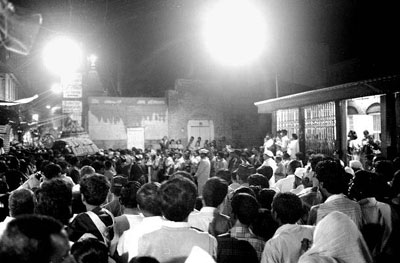
The procession enters Dwarkamai about ten minutes later, where again there is an assembled crowd waiting for its arrival and jostling for a view. Here the photo is placed on the decorated silver palanquin to the accompaniment of more exuberant bhajan. This takes about fifteen minutes. Mandir staff and locals then carry the palanquin to the Chavadi, where people are waiting inside and out
As the palanquin approaches the Chavadi, we come to the climax of the evening. The palanquin is parked outside, and the picture, draped in gold-embroidered red velvet, is carried inside the Chavadi and greeted as if it were Baba himself entering. People may prostrate (if they have the space!), shout his name, say a silent prayer, or gaze longingly on his face. Baba's picture is then settled into place on a silver throne and arati is performed. Finally, the whole group returns to the Samadhi Mandir. Here, a local person receives the satka and padukas, and the Kote brothers hand back the picture and collect a coconut as prasad. The coconut is kept beside Baba's statue until the final night arati is over (around 10 p.m.). The picture is returned to the Chavadi after morning arati the next day
During the procession, lalkari is performed. There is no direct translation for "lalkari", but it means the ceremonial shouting of slogans or words of praise (traditionally used for royalty) such as "Long live Sai Baba!" There are specific points where this is done during the utsav, just as there were when the saint of Shirdi covered the short distance by foot nearly a hundred years ago.


